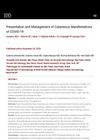Cutaneous Manifestations of the COVID-19 Pandemic in Schoolchildren and Adolescents
January 2023
in “
Acta dermatovenerologica Alpina, Pannonica et Adriatica (Tiskana izd.)
”

TLDR The article concludes that schoolchildren and adolescents experienced various skin issues during the COVID-19 pandemic, including acne from masks and other skin reactions from the virus and vaccines.
This review article highlights the skin issues faced by schoolchildren and adolescents aged 6 to 18 years during the COVID-19 pandemic, including those caused by personal protective equipment (PPE), SARS-CoV-2 infection, and the vaccine. Mask-related acne is prevalent due to microbiome changes and skin disruption. Infections can lead to chilblain-like lesions, erythema multiforme-like eruptions, and multisystem inflammatory syndrome, with a prevalence of cutaneous manifestations estimated between 0.25% and 3%. Hair and nail conditions such as alopecia areata and telogen effluvium have also been reported. Vaccine-related skin issues in children differ from adults, with cases of vitiligo, toxic epidermolysis, and alopecia areata noted. Chilblain-like lesions are the most common skin manifestation, occurring in 67.5% of cases, and may aid in early COVID-19 detection. No causal link between COVID vaccines and chilblain-like lesions has been confirmed, but isolated cases of alopecia and skin reactions post-vaccination have been observed. The review underscores the importance of recognizing these skin manifestations for early detection and management of COVID-19 in the pediatric population.








